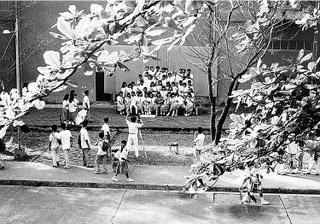
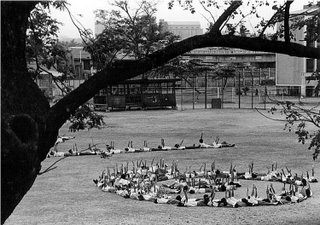 Natural frames, as the term suggests, are those found in nature, in your surroundings like windows, doorways, arches, trees, a fence, etc. and which can be effectively used to emphasize or to isolate your subject. If you want to make better photographs almost instantaneously, you should make use of natural frames.
Natural frames, as the term suggests, are those found in nature, in your surroundings like windows, doorways, arches, trees, a fence, etc. and which can be effectively used to emphasize or to isolate your subject. If you want to make better photographs almost instantaneously, you should make use of natural frames.
In the first picture above, for example, the scene (a high school class having their group picture taken) is framed by the branches of a tree. I was on the 2nd floor of a building overlooking the scene and I purposely placed that class within the frame created by the branches.
In the second picture above, I had been shooting lots of pictures of the practices for the field demonstration at ground level. I wanted to shoot from a higher point of view, so I went up to the 2nd floor of a nearby building. I got a good view of the practices and was able to use the branch of an acacia tree to frame the scene. If I didn’t use the branch as a natural frame and just focused on the practicing students, I would have had empty spaces on the upper and left side of the image. Plus, the branch (extending from the left to right hand side of the image) complements the outstretched hands of the students.
Kinds of natural frames
Natural frames can be:
- full or partial
- in sharp focus or out of focus
- local (made up of objects which are part of your subject)
- composite (a frame within a frame)
- running along the top or bottom of the picture, or along the sides
- in the foreground or in the background.
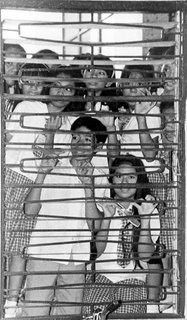 Some very handy natural frames are doors and windows, as shown by the picture of the students above.
Some very handy natural frames are doors and windows, as shown by the picture of the students above.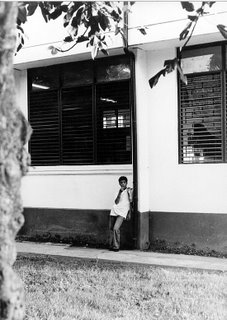 In the picture above, my primary natural frame is the partial, slightly out of focus santol tree on the left hand side at the foreground. The post and the windows behind the student also serve as natural frames. A natural frame may either be in the foreground or in the background.
In the picture above, my primary natural frame is the partial, slightly out of focus santol tree on the left hand side at the foreground. The post and the windows behind the student also serve as natural frames. A natural frame may either be in the foreground or in the background. In the picture above, I used the fluffy dolls to frame my cute nephew Gino (who looks like me!) and to complement the image of a one year old child just learning how to crawl.
In the picture above, I used the fluffy dolls to frame my cute nephew Gino (who looks like me!) and to complement the image of a one year old child just learning how to crawl.The walkabout
How do you come up with good, creative natural frames? By carefully choosing your viewpoint; don’t just point your camera at your subject and shoot at once. Good photographers do the “walkabout” which simply means moving around your subject and looking for objects which can be used as natural frames. In the next three pictures below, for example, I shot the water tank (a famous landmark in Rizal High School in Pasig) at various times, from various angles, and using different natural frames.
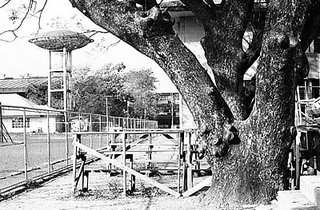
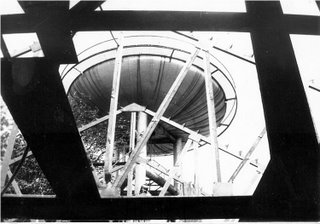
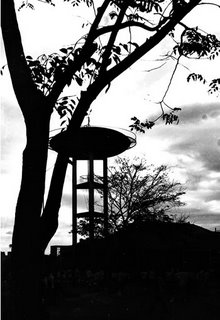 I even got a picture of this water tank as a reflection, as in the picture below. But this time around, it is the reflection that serves as a natural frame for the student. (In a future posting, we will discuss reflections as a photographic subject.)
I even got a picture of this water tank as a reflection, as in the picture below. But this time around, it is the reflection that serves as a natural frame for the student. (In a future posting, we will discuss reflections as a photographic subject.)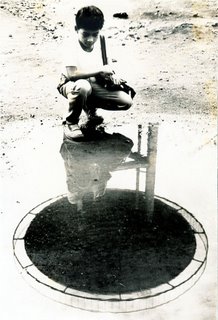
9 Photo Composition Tips (featuring Steve McCurry, 2002 Photographer of the Year, American Photo Magazine); Tip No. 4: Natural frames






No comments:
Post a Comment